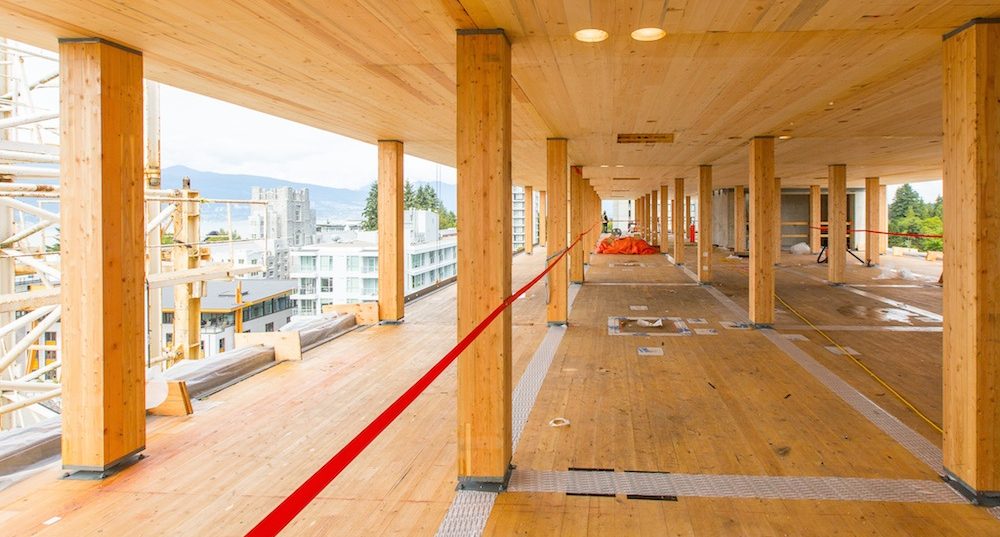World's tallest wood building at UBC reaches structural completion

The world’s tallest wood building at 18 storeys, 174-feet-tall, is now standing close to the centre of the University of British Columbia’s Point Grey campus.
The skeleton structure of the so-called UBC Tall Wood Building, the first phase of the Brock Commons student residence, built immediately north of the North Parkade and east of Brock Hall on Walter Gate Road, reached structural completion earlier this month. The floor plates and supporting structures above the second floor are made of laminated lumber beams glued together under pressure, and the facade of the tower is comprised of prefabricated wood panels.
Researchers and proponents of tall wood buildings say such structures do not possess a greater fire hazard, to the extent that wood can be deemed a safer material than steel. Charred wooden surfaces protect the structural wood underneath whereas steel structures are weakest at the points of where it supports a post.

Image: UBC Public Affairs
Designed by Vancouver-based Acton Ostry Architects, the building will literally be a living experiment when 4o0 students move into the units in September 2017. It is all part of an effort supported by the federal and provincial governments to showcase and promote the use of wood materials for new methods of construction.
The building cost $51.5 million to construct, with $47.07 million from UBC, $2.34 million from the federal government, $1.65 million from the provincial government, and $467,000 from the Binational Softwood Lumber Council. Special building code exemptions were granted for the project as wood buildings in BC are currently limited to six storeys.
Upon completion, researchers with the university and the lumber industry will closely monitor the performance of the building to collect the metrics needed to further promote wood construction.
“This remarkable building, the first of its kind in the world, is another shining example of Canadian ingenuity and innovation, an apt demonstration of how Canada’s forest industry is finding new opportunities through technology and innovation — opening up a world of possibilities for our forest and construction industries,” said Jim Carr, Canada’s Minister of Natural Resources, in a statement.
However, the entire building is still built on top of a concrete foundation and podium that reaches the floor plate for the second level. There are also two concrete cores for further seismic stabilization and to provide an enclosure for the emergency staircases and elevators. According to the designers, the building design exceeds required fire ratings and standard seismic safety requirements.

Image: UBC Public Affairs
The wooden structure was completed four months ahead of schedule, proving that wood materials are a faster construction method, and work will now begin on completing the interior of the building for habitation. Construction began in the fall of 2014.
The building is aiming for a LEED Gold environmental standard, in part to how the use of wood instead of concrete and steel reduced 2,432 metric tonnes of carbon dioxide.
UBC will add 2,800 student beds on campus from 2010 to 2016, and a further 3,000 beds will be completed from 2017 to 2020.
A number of buildings on campus, including the recently built UBC Nest Student Union Building, feature the extensive use of wood as intentional showcase projects. Another project in downtown Vancouver designed by internationally renowned Japanese architect Shigeru Ban, known for his use of wood and paper as primary construction materials, aims to be the world’s first tallest hybrid timber building. The first 12 floors will be constructed using the traditional steel and concrete methods while the remaining seven floors will be constructed out of wood.
The world’s previous tallest wood building was a 14-storey structure in Bergen, Norway.

Image: UBC Public Affairs

Image: UBC Public Affairs

Image: UBC Public Affairs

Image: UBC Public Affairs

Image: UBC Public Affairs

